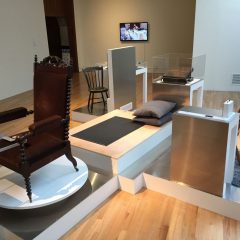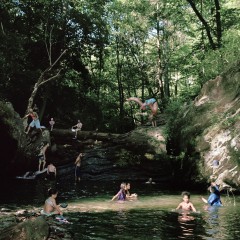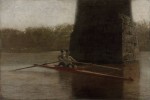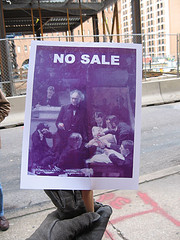
my favorite sign
This was a morning to stay in bed with the blankets pulled high–a Sunday with gray skies. The air held intimations of winter–damp and cold. Nonetheless, about 30 people rallied this morning to protest the sale of the Thomas Eakins masterpiece, The Gross Clinic, and its imminent removal from Philadelphia first to the National Gallery and then to Bentonville, Arkansas.
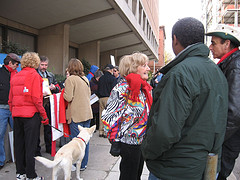
protesters gather. That’s art writer Ann Fabbri in the center
At 10 a.m. this morning, people started arriving at the rally. Painter Stanley Bielen, one of the early arrivals with a pile of hand-made signs to share, said “Eakins is such an important guy–even if you’re not in a realist tradition. …I feel like I have to do something, and here I am!” Bielen went to the Pennsylvania Academy of the Fine Arts, the same place where Eakins himself taught–until PAFA canned Eakins for exposing female art students to nude male models, and probably also for being irrascible, intemperate and impolitic.

The crowd reached its height near 11 a.m. This photo was taken by Herb Moskovitz, a set designer who works with Philadelphia Recreation Department arts programs.
Another artist at the rally, Frances Galante, looked on the bright side of the $68 million sale price. “I’m delighted that a Philadelphia 19th century traditional painter made it into that [price] category,” she said. Galante shows at Artists House, a PAFA alum stronghold that features figurative work that harks back to that 19th century tradition.
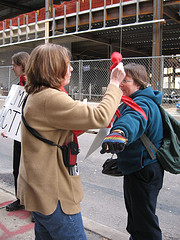
Artists Equity President Karen Kappe Nugent puts a red scarf on Jefferson Occupational Therapy alumna Joan Halbert
Artists Equity sent out calls to its members about the rally, and most of the artists at the protest were Equity members. Equity President Karen Kappe Nugent handed out red scarves as well as signs. Why red? I asked. The city’s blood loss, she said. But not one to dwell on the past, she went on. “If [The Gross Clinic] leaves, we will be saddened, but we want to stimulate the economy for living artists in the city, in Philadelphia and New York.” She proposed that one percent of the sale price–i.e. $680,000–be reinvested in new art by living artists. “Art’s a smart investment.”
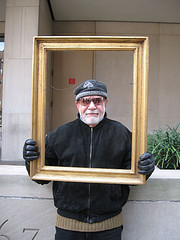
Artist Sea Kaplan fills Patrick Connors’ empty picture frame
Protest organizer Patrick Connors, a painter who teaches at PAFA, spoke briefly. He promised to be back in the same spot at 10th and Locust every Sunday until the painting leaves town, and asked that others join him in letting Jefferson’s leaders know that the painting is part of Philadelphia’s cultural patrimony. My favorite bit was his visual aid–an empty picture frame.
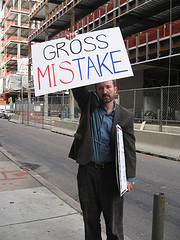
Stanley Bielen holds up protest sign
Then Bielen called on people to contact the politicians–the mayor, city councilmen–and tell them the sale is “a terrible mistake.”
A spokesperson for Jefferson told me that the institution was following New York Times writer Michael Kimmelman’s rules for selling a civic treasure. But those rules, as Kimmelman wrote on May 18, 2005, state:
So in the future, I suggest new rules: besides giving local museums a reasonable period of time to match the price of any art sold by any public- which is to say any nonprofit – institution, there should be more open procedures and time for public scrutiny. Total transparency.
Jefferson certainly did not measure up to these standards. Forty-five days is not a reasonable period of time for matching the $68 million price tag. It’s window dressing. And the process was behind closed doors.
Kimmelman’s rules were inspired by a similarly conducted sale of Asher B. Durand’s “Kindred Spirits” by New York Public Library–to the very same purchaser, Wal-Mart heir Alice Walton, by the very same broker, Sotheby’s, for the very same institutions, Crystal Bridges and the National Gallery. The full text of Kimmelman’s article is here .
For more images from this morning, visit my Flickr set. For the previous post on the sale of the Gross Clinic and links to prior items in the thread, go here.



